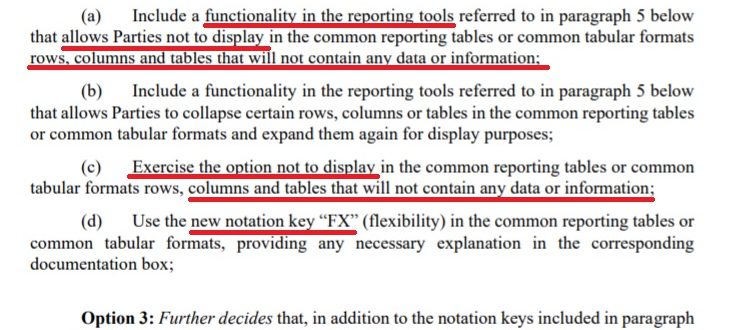TRANSPARENCY: A FEW HOURS AND THREE OPTIONS ON THE TABLE
Now in the third day of political negotiations, in the corridors and rooms national delegates continue to discuss how to formulate (verbatim and in charts) one of the most awaited decisions at this COP, the one on transparency in the reporting of current and future national emissions. We have discussed why this issue is so important in an article published by Wired.
Basically, we have been discussing for years how to set up a spreadsheet in which each country can independently report data on its by sector emissions. The new reporting system, enhanced and common for all countries from 2024 (the so-called Enhanced Transparency Framework), will give the Paris Agreement on climate a feature that has always been absent in international politics: the possibility of comparing, based on aggregated national reports, the actual commitments of each State and their implementation in real time, so to speak. A sort of fact checking that, in essence, leads to the construction of a new international regime under the aegis of the United Nations, in which every country in the world transparently communicates its work and makes it available to scientists, politicians from other countries and observers from civil society. Precisely for these reasons the negotiation on transparency is not only one of the most scientifically complex, but also politically relevant of the entire climate issue.
The first week, as Aurora Audino told us a few days ago, ended with a request for additional time to arrive at defined drafts on the main issues. Between Monday and Tuesday, the negotiations carried on a technical way after the indication, by the President of the COP Alok Sharma, to continue with the facilitators who had already led the work in the first week, to arrive at definite drafts by yesterday afternoon (Tuesday). The drafts were published on the UNFCCC website at 8.55 am yesterday morning and remain, so far, the only ones available for observers. We know from the corridors that the negotiations then continued until at least all afternoon, probably the COP President will provide more updates in the update plenary scheduled for this day.
Dominating the debate is the need for flexibility clauses for countries with less reporting capacity. In short, we are looking for a mediation between ambition and flexibility that will bring together all countries, from the most ambitious with experts, scientists, research centres able to provide complete and updated data, to those who ask for support in this regard to the United Nations and those, finally, that despite having all the reporting capabilities appeal to their status of “developing country” according to the division of the world within the UNFCCC, now dating back to 1992, to hide an unwillingness to share their data with others behind alleged lack of scientific staff.
Thus, in the draft circulated at 8:55 a.m. yesterday, three options for applying this flexibility in future spreadsheets appear:
1. Creation of an automatic function in the system that hides the rows or columns in which a country has not entered any data (for example, on emissions of a certain type of gas in a certain sector of the economy),
2. Possibility for countries to exercise an option, whereby they may not show rows or columns in which they have not entered any data,
3. Use of a symbol, “FX” (flexibility), in the boxes that they do not intend to fill in, explaining the reasons in the margin.
While a concession of flexibility will be inevitable, especially considering the difficulties smaller countries have in finding and systematizing data on their emissions, at the same time the choice between one option and another will allow the international community to monitor progress with varying degrees of accuracy.
To support the smallest in reporting and overcome, in the medium term, these initial difficulties in view of the entry into operation of the new system, a new tool will complement the classic loans of human resources from major international agencies. Just yesterday afternoon, the Partnership on Transparency in the Paris Agreement (PATPA), a cooperative initiative launched by Germany, South Korea and South Africa in close collaboration with FAO, presented a new tool, called the “Roadmap Tool”, to support governments in the drafting of their first biennial report under the new system by 2024. The presentation was accompanied by comments from some Government-testers, notably Mongolia and Cambodia, who highlighted the difficulties of their countries in doing this work on their own without such support.
Meanwhile, the negotiations continue. In the latest version circulated of the draft conclusions of this COP, reference is made to the need for countries to be ready in view of the entry into force of the new reporting system, after (point 70) satisfaction with the completion of the definition of the relevant rules (thus completion of the Paris Rulebook), a definition that at this point seems destined to be completed within the week:
Keep following us via our COP Bulletin for updates following today’s plenary.
by Jacopo Bencini, Policy Advisor and UNFCCC Contact Point

